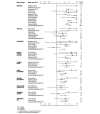Delirium risk factors in elderly hospitalized patients
- PMID: 9541379
- PMCID: PMC1496920
- DOI: 10.1046/j.1525-1497.1998.00047.x
Delirium risk factors in elderly hospitalized patients
Abstract
Objective: Delirium is frequent in elderly hospitalized patients. Many studies have examined its risk factors, but results have been quite variable. Thus, the goal of this study is to identify through systematic literature review the risk factors associated with the development of delirium in hospitalized geriatric patients.
Measurements and main results: First, MEDLINE/CURRENT CONTENTS databases were screened for relevant articles published from 1966 to December 1995, and from bibliographies of identified articles additional reports were selected. Second, the reports were screened by two different investigators and retained only if meeting the five following criteria: (1) original research in French or English; (2) prospective study; (3) patients over age 50; (4) minimum of one risk factor examined; (5) acceptable definition of delirium. Third, the methodology of each study was graded according to specific criteria for risk factor studies. Fourth, risk factors were identified and tabulated, unadjusted odds ratios (ORs) were computed, and where appropriate a combined OR with the Mantel-Haenszel estimator was calculated. Twenty-seven articles were retained meeting all of the above criteria. Among these studies, 11 were done on medical patients, 9 on surgical patients, 2 on medical and surgical patients, and 5 on psychiatric patients. In total 1,365 subjects with delirium were studied. Sixty-one different risk factors were examined, the five most common being dementia, medication, medical illness, age, and male gender. Mantel-Haenszel estimator was calculated for 10 risk factors, the most strongly associated being dementia (OR 5.2; 95% confidence interval [CI] 4.2, 6.3), medical illness (OR 3.8; 95% CI 2.2, 6.4), alcohol abuse (OR 3.3; 95% CI 1.9, 5.5), and depression (OR 1.9; 95% CI 1.3, 2.6). Methodologic weaknesses were present in many studies.
Conclusions: Despite methodologic limitations, certain risk factors for delirium seem to be consistent and could help identify high-risk patients. These risk factors include dementia, advanced age, and medical illness. Other risk factors appear to play a contributory role in the development of delirium in elderly hospitalized patients.
Figures
References
-
- Francis J. Delirium in older patients. J Am Geriatr Soc. 1992;40:829–38. - PubMed
-
- Levkoff SE, Evans DA, Liptzin B, et al. Delirium: the occurrence and persistence of symptoms among elderly hospitalized patients. Arch Intern Med. 1992;152:334–40. - PubMed
-
- Thomas RI, Cameron DJ, Fahs MC. A prospective study of delirium and prolonged hospital stay. Arch Gen Psychiatry. 1998;45:937–40. - PubMed
-
- Lewis LM, Miller DK, Morley JE, Nork MJ, Lasater LC. Unrecognized delirium in ED geriatric patients. Am J Emerg Med. 1995;13:142–5. - PubMed
Publication types
MeSH terms
LinkOut - more resources
Full Text Sources
Medical

